On the FritzBox Configpage, there is a "DSL Status"-Subpage. Have you checked which bandwidth your dsl connection has?
I found the GL-B1300 - https://www.gl-inet.com/products/gl-b1300/ which is supported by openwrt. See https://openwrt.org/toh/hwdata/gl.inet/gl.inet_gl-b1300
Could this device be used for wirelisse bridging with my tv / dvb-box? I mean I connect the ethernet-port of the GL-B1300 to the tv and the GL-B1300 connects via wifi to a router?
The GL-B1300 supports mesh, so I can I setup a mesh-system with a 2nd GL-B130 for my mobile phones? As "main station" I am thinking of a Zyxel Armor Z2 [NBG6817].
The advantage of this device is, that the stock-fw is more are less openwrt.
The Fritz.page says ADSL2+ 15.000 kbit/s
There is the same problem with a coax-cable. None exists to this place.
You will have to try it. Many have success with WDS or other bridging technologies with a variety of Atheros-based devices.
Your insistence on using "stock firmware" still puzzles me, even more so as this is an OpenWrt forum, and extended discussions of stock firmware and its capabilities and performance belongs on the manufacturer's support forums, not here.
Here in the EU we have the right to return an order within 14 days. I do not want to flash a device, which I return, this is not fair to the next customer. I am not so familiar with flashing that I am sure I can flash it back to the original state. And that is why, I want to test with stock-fw first. With my 6 TL-WR1043ND I bricked one and it wasn't the 1st 1043 I flashed, so I was familiar how to do it.
But with the GL-B1300 I can test with the Firmware I get, I think to replace the patched openwrt-FW with the latest openwrt-FW should not be a big problem, when I know, that it works.
After reading https://forum.gl-inet.com/t/gl-b1300-using-as-secondary-ap/4932 I think this could be problematic. But in the discussion there is a patch mentioned: https://github.com/chunkeey/LEDE-IPQ40XX/commit/a04cf208fe317074502f7ea81dafa828c89b74bb
Can anybody telle me, if this patch is included in the latest openwrt?
The configuration for beamforming in hostapd is already in place in OpenWRT for chipsets that support it, such as on Netgear R7800:
vht_capab=[RXLDPC][SHORT-GI-80][SHORT-GI-160][TX-STBC-2BY1][SU-BEAMFORMER][SU-BEAMFORMEE][MU-BEAMFORMER][MU-BEAMFORMEE][RX-ANTENNA-PATTERN][TX-ANTENNA-PATTERN][RX-STBC-1][VHT160-80PLUS80][MAX-MPDU-11454][MAX-A-MPDU-LEN-EXP7]
I want to let you know, that I changed all my TL-WR1043ND v1.8 to Openwrt 18.06.1 (from Openwrt 10). The routers have become very very unstable, with Openwrt 10 I did reboot once a year or 2 years, now it can happen that I have to reboot a few times a day.
But the very interesting thing is the speed.
I noticed speeds now from 11.5-12M/s (according to lftp during a video-file transfer), which is great but then after hours I see 5-6M/s or even 2-3M/s. When I check the other networks, I don't see very strong neighbours. I changed to channel 11 and there is only 1 signal with -82dB. My wds-client has about 39dB and the master ap has 50-60dB.
Do have another explanation for the speed differences than a bad performing of my TL-WR1043ND routers? It looks like the problems are not because of the thick stonewalls only.
TL-WR1043ND v1.x
Atheros AR9132 at 400 MHz
8 / 32
Atheros AR9103
32 MB RAM, so potentially RAM exhaustion is causing the degradation over time.
A 2010 unit, based on https://wikidevi.com/wiki/TP-LINK_TL-WR1043ND_v1.x, it isn't the latest hardware, but, apart from the crippling lack of ROM and RAM, should be serviceable on 2.4 GHz at up to a couple hundred Mbps throughput, without bandwidth shaping.
The TL-WR1043NDv1 works, but was released with an early draft-N wireless card (AR9103), which is known to be problematic (silicon bugs), furthermore the PSUs are known to die early; aside from the RAM shortage.
Well I used 5 pieces TL-WR1043NDv1.8 for 7-8 years without big problems and Openwrt 10, now with 18.6.1 the problems started and they freeze a few times a day. But I agree, that they are old and I have to change them.
In this thread a GL-AR750 was recommended, I decided to try a GL-B1300 and hoped that the antennas are better. But the signal is far away from my old TL-WR1043ND
See the chart. PA04 is the TL-WR1043ND master-wds-ap, 1 floor higher, the 2 client-routers are in a distance of about 1m. PA34 is the TL-WR1043ND WDS-Client. The chart was taken with my mobile phone in a floor below the master-ap. Interesting is, that the signal of PA32 with 2 floors difference is better. The difference in meters is wrong, it is shorter for sure, maybe 10m but with thick walls.
You see that the signal of the TP-WDS-client is very bad, that is why I am searching for another router and why I am talking about beamforming.
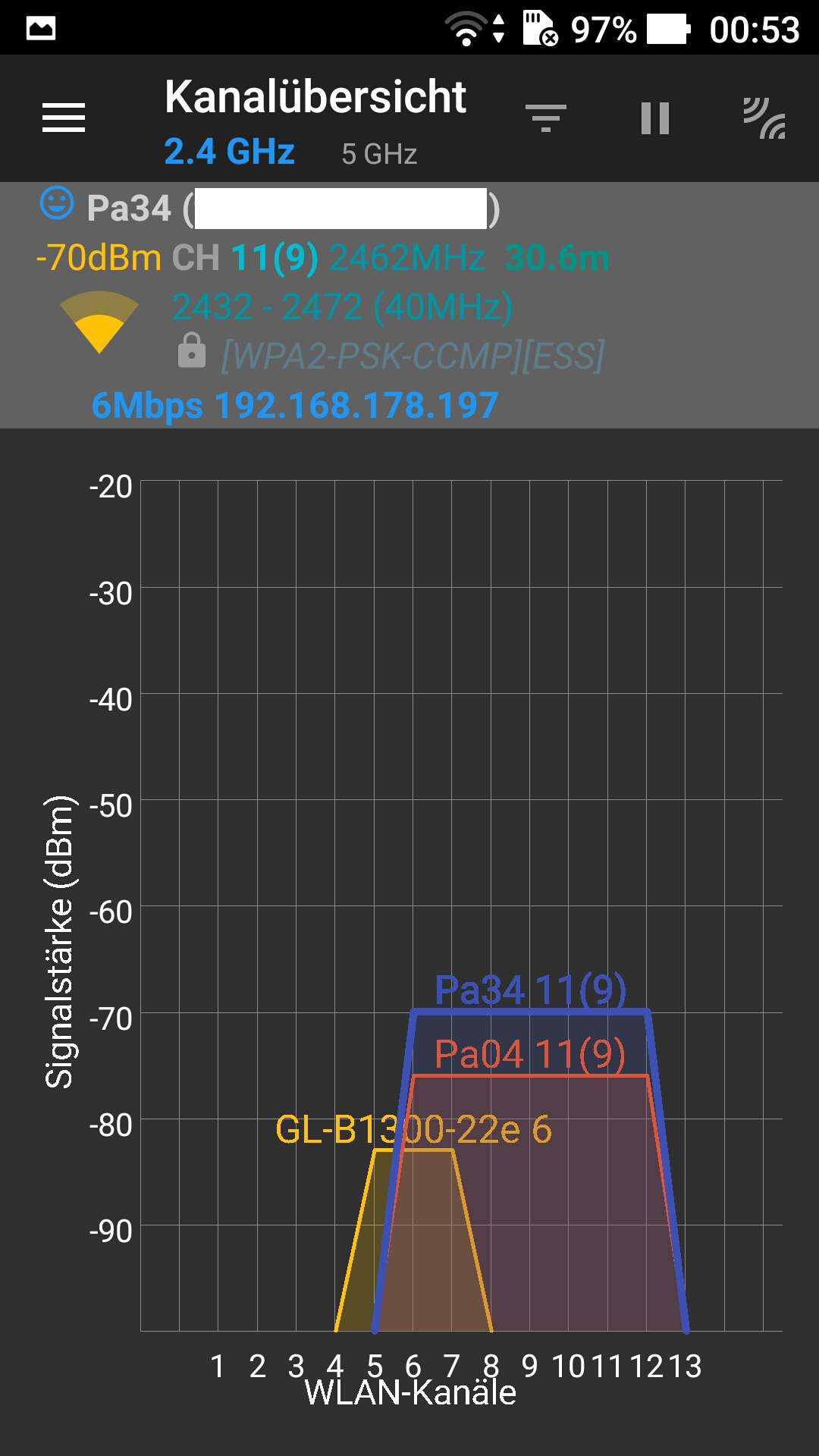
That distance is the path length estimate. The signal probably reflects off multiple surfaces, not penetrating the thick walls.
Turn off the 40Mhz channels on the channel 11 devices, they will just interfere with channel 6.
I'm not clear on the configuration, but how close are you to the gl b1300 at that snapshot? Have you set the power levels manually? How is your speed test result? What really is the problem you are trying to solve?
My problem is a poor signal, whatever the reason is.
I changed the power level from auto to manually and set 23. Bandwidth was set to 20, although it was changed to 20 most times automatically.
I made again some screenshots at the place where I need a better signal.
PA04 is the master-wds-ap-router (TP-Link)
PAG4 is the client-wds-router (GL)
PA04 is in the ground floor
PAG4 is in the 1st floor
location of the screenshots is 1/2 floor below ground floor.
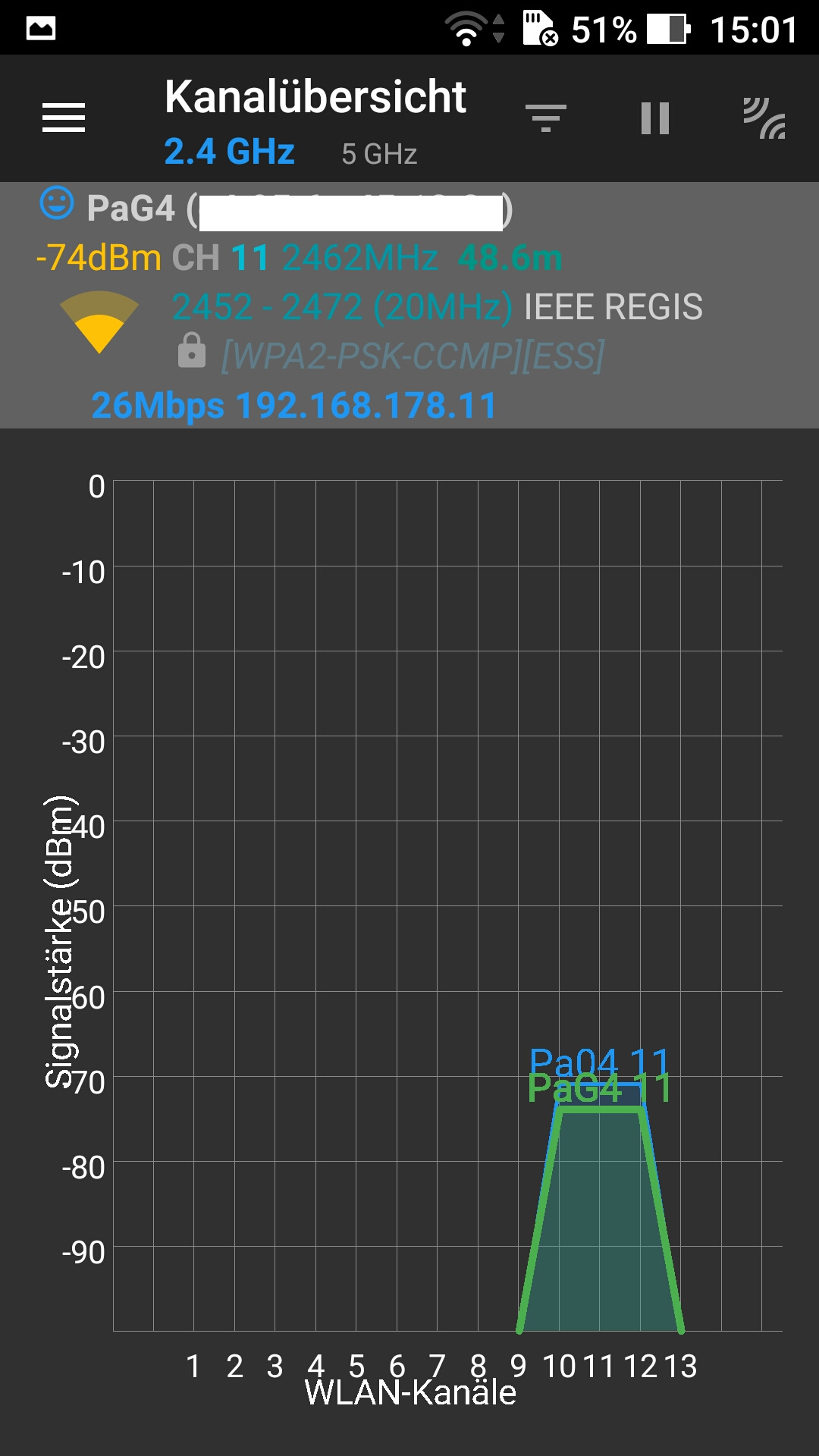
You see there is not a big difference between Pa04 in the ground floor and PaG4 in the 1st floor. When I use a TP-Link instead of the GL in the 1st floor, the signal is there a lot better than Pa04. I cannot change the router location significantly. The signal in the room below the ground floor depends very much on the height in the room. I put the mobile phone for the test on a bed.
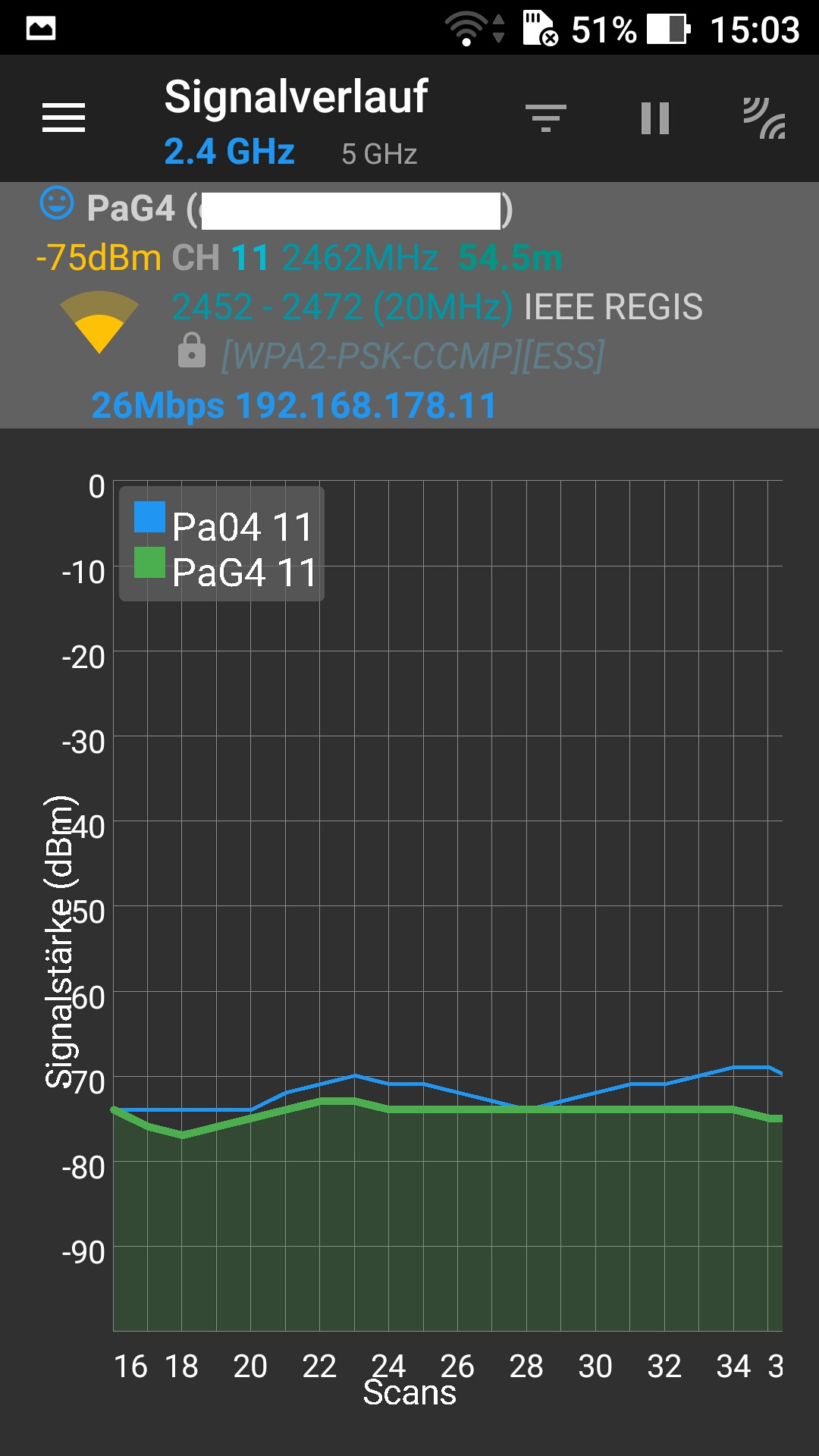
Again you see that the 2 signals are very similar with the GL.

26Mbps are a very bad signal.
For comparison, I created screenshots in the room, where the GL-router is located. Distance between phone and GL ist about 2.5m
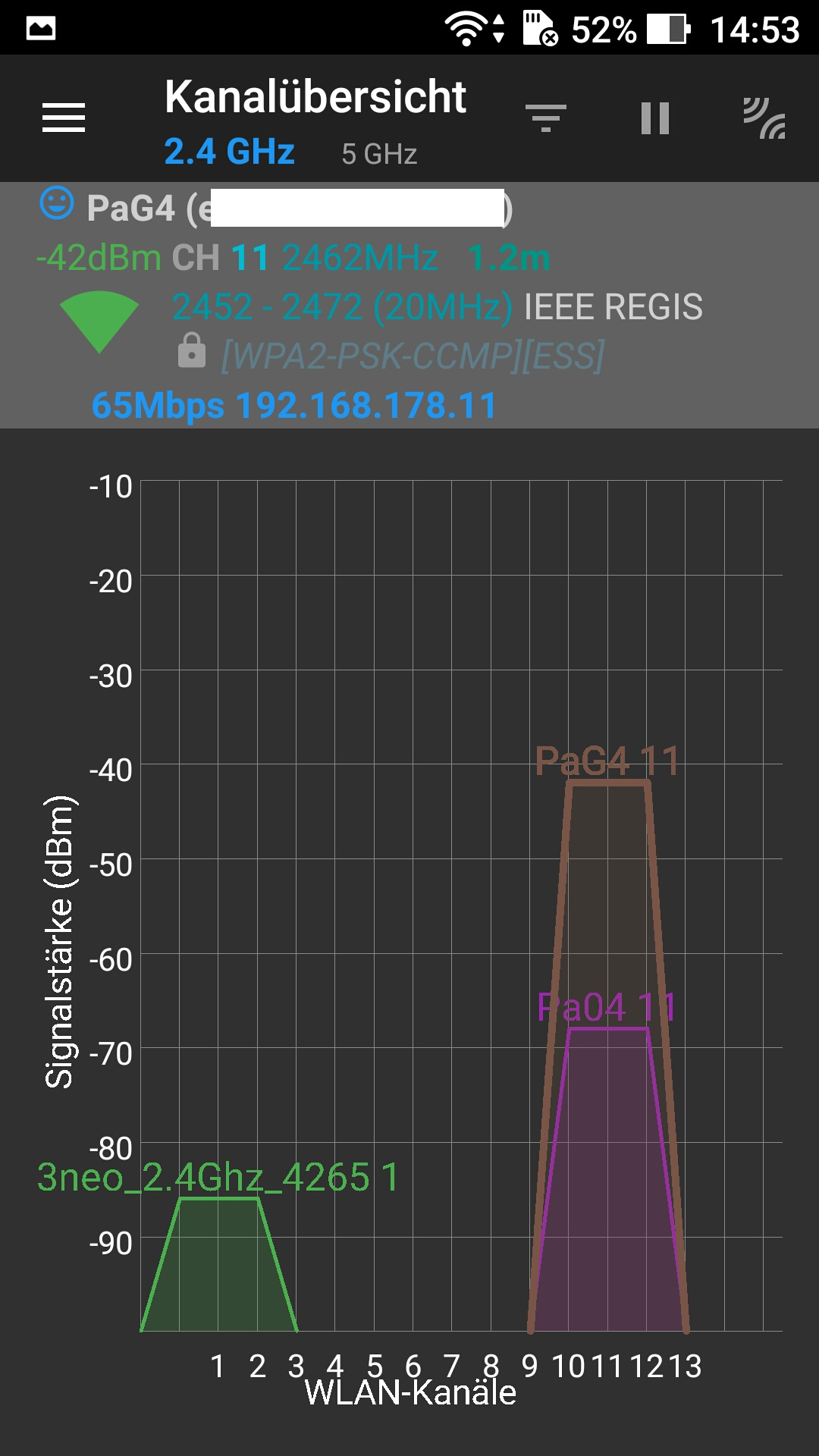
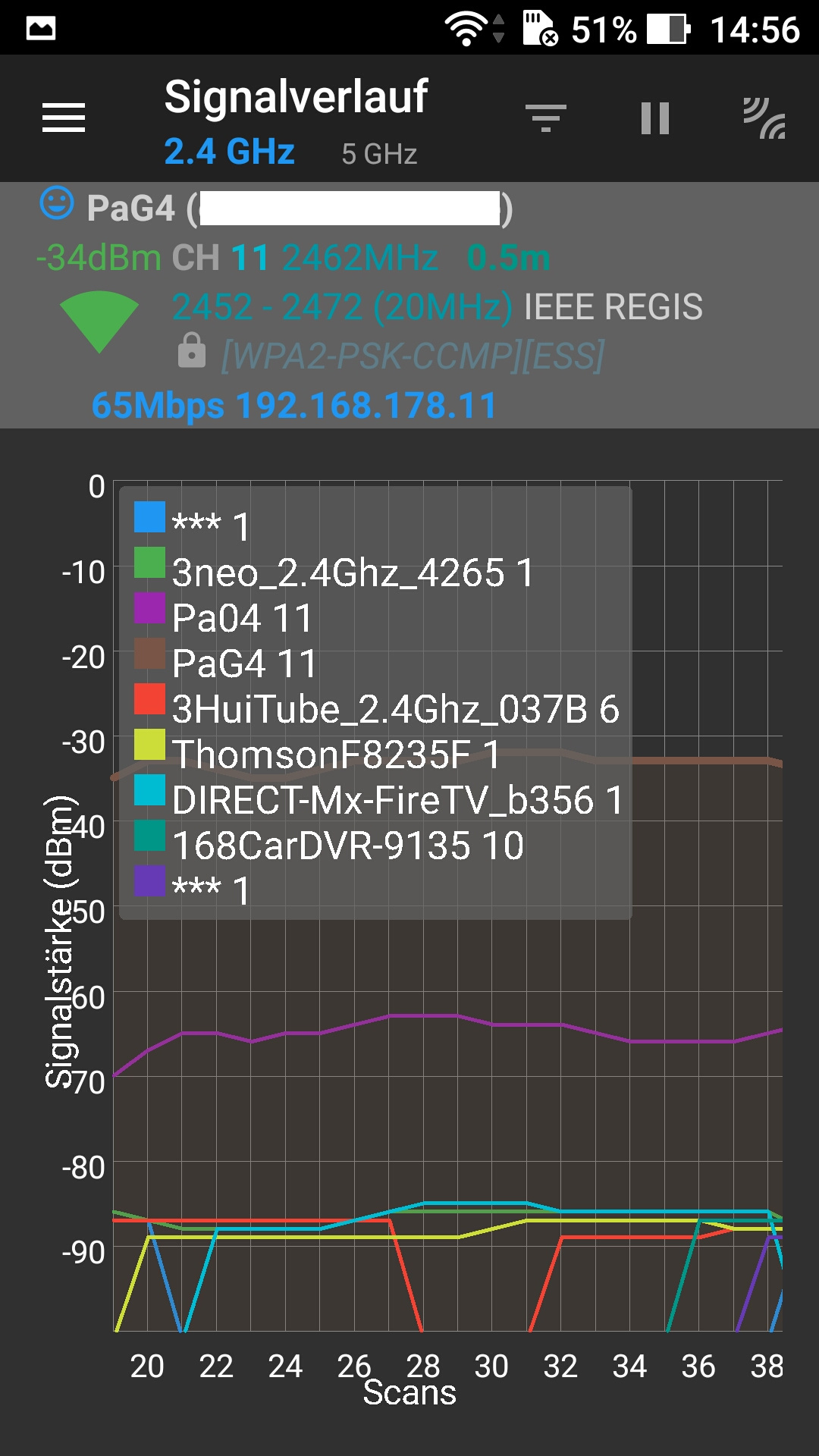
So for my understanding, the GL-router (PaG4) is useless for my as wds-client. The wds-master-ap (Pa04) is very similar re signal quality in the room below the ground floor. If I use the old TP-Link-router as wds-.client at the same place, the signal is about -10dB better.
Since I cannot change the location of the routers, I have to find technical solutions.
As discussed earliere I also would like to receive videos from the ground floor in the 1st floor with 5Ghz. This cannot be tested at the moment, since I do not have 2 5Ghz-routers.
You are trying to receive a signal in the floor below, but likely the thick floor attenuates the signal. Can you move the PAG4 router so that it can have a better path to your desired location? Imagine it is a lightbulb and at the location you are trying to see the light. It might be reflected off a wall and then leak under the crack in a door or something. Try to place it so it can illuminate this path better. Maybe only a meter or two difference might make the difference.
The distance estimate is 48 m so take that seriously for a moment, perhaps it goes out a window and reflects off a neighbor building and back in a lower floor window, but you could move it so instead it comes down a stairwell?
Hard to believe, that the signal comes from out of the window. It would have to go out of the window, around the corner of the house and then back to a window. Interesting is, that the signal in the "cellar", actually the building is on a flat hill, is better from the 1st floor than from the ground floor. I think the advantage of the TP-Link are the 3 external antennas, while the GL has internal antennas only. The distance between PaG4 and "cellar" is about 2x room-height, let's say 2x2.5m=5m + horzontal distance, maybe 7m.
I cannot move the routers a lot, the PaG4 is on a dvb-linux-box which is a little below of a tv. Maybe I can move it 10cm horizontally. Compare conecto LM-FS02B (conecto LM-FS02B)
The Pa04 (master) can be moved horizontally about 1m.
Am I right, that external antennas are better for my needs?
Unless you're willing to spend around €50 or more per feed line, the feed lines are likely to attenuate more than the antennas will gain. Also be aware that many devices now have internal antennas for at least 2.4 GHz.
There are limits to what a "technical" solution can accomplish with a given technology. 802.11 may not be suitable for your application as you have constrained it.
Beamforming isn't going to gain you more than a couple of dB on the link, if it actually works. Beamforming with a small number of antennas/radios is good at steering N-1 strong nulls, but you can't make power out of nothing.
Radio waves in GHz bands are a lot like light. Yes they can pass through some materials like gypsum wallboard, but they probably aren't going through several cm of concrete for example. Your signal is maybe -85dB and leaves antenna at 20dB so it's attenuated by a factor of 10 billion or so. Maybe it is going through windows. Is the AP sitting on a metal shelf reflecting the signal away, like that device you showed? I'd start moving things around while monitoring, you could easily get 10 db by not reflecting your signal away accidentally.
The master-ap-router is on a chipboard, 1.5m above the ground before a brick-wall in a corner behind a tv. I will try to change the place a little and look if it gets better, but I fear I can't change the place of the client a lot. Maybe I can give the client-router (GL or whatever) on the board above the tv, but then the distance to the master ap becomes bigger.
Can you explain this a little bit more?
Jeff was thinking you wanted to put your antennas separated from the body of the device, and then you need very high quality coax to make it work
Yes, that was my thought -- a meter or two of eBay- or consumer-grade coax will often negate any gan an external antenna might have, especially at 5 GHz.
Yes, assuming that the quality of the antenna design and execution in the device is comparable, one with a 20 cm long antenna is probably "better" than one with a 4 cm long internal antenna. You're probably only talking 1-3 dB though, not the 20-ish dB that you seem to be looking for. Then again, the internal antennas in my Archer C7 seem to work well on 2.4 GHz.